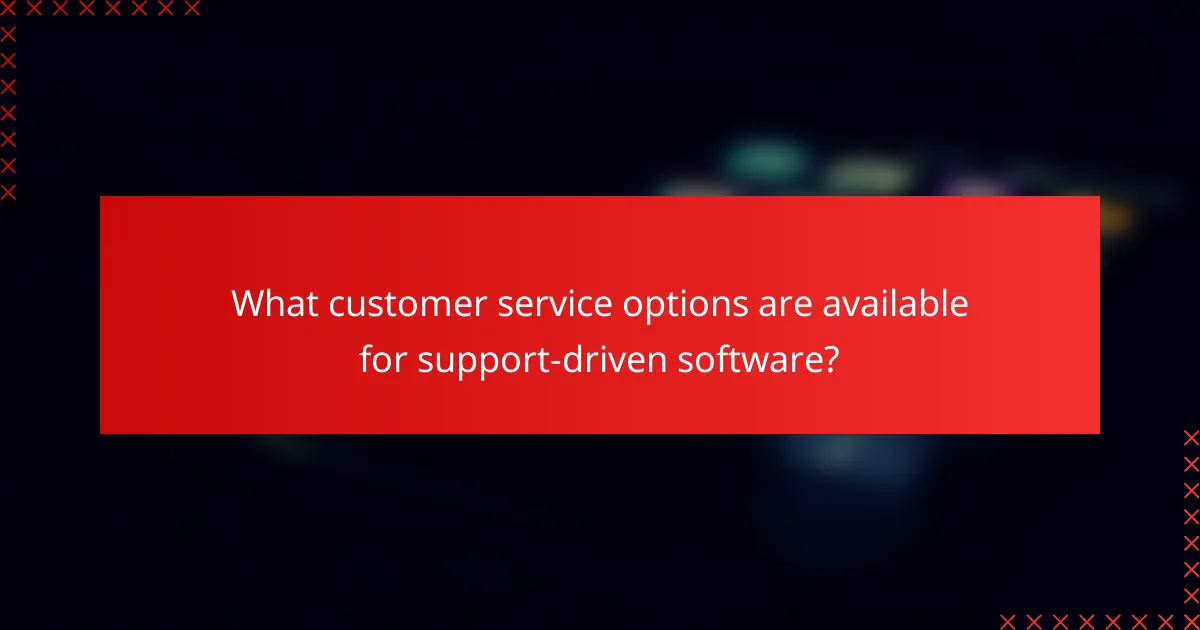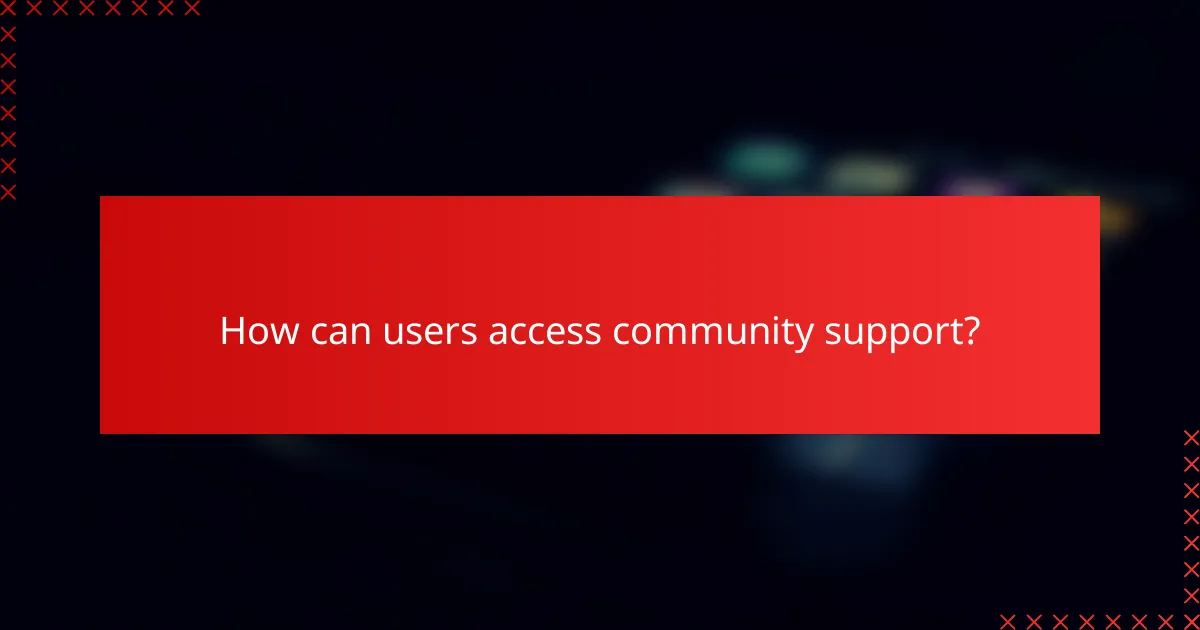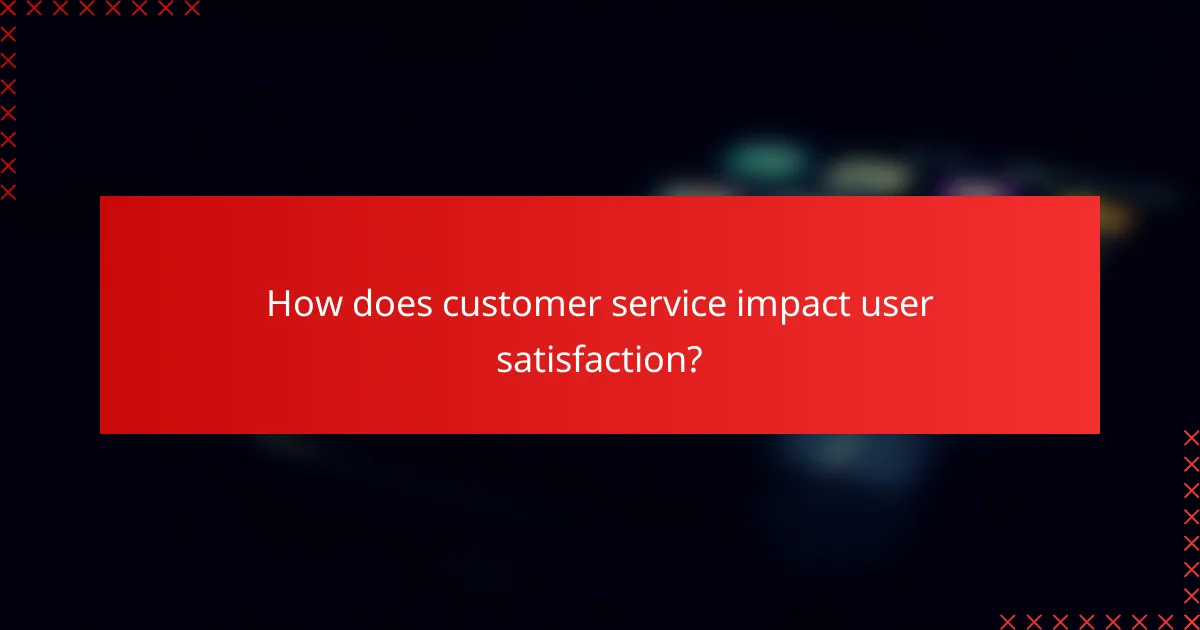Support-driven software prioritizes customer assistance by offering multiple service options, such as 24/7 live chat, email, and phone support, to meet diverse user needs. Additionally, users can engage with a vibrant community through online forums and social media groups, facilitating knowledge sharing and problem-solving. To enhance user experience, a range of tutorial resources, including video guides and live training sessions, are available to help users effectively navigate the software.

What customer service options are available for support-driven software?
Support-driven software typically offers a variety of customer service options to ensure users receive timely assistance. These options often include 24/7 live chat, email support, and phone support, each catering to different user preferences and needs.
24/7 live chat support
Many support-driven software solutions provide 24/7 live chat support, allowing users to get immediate help at any time. This option is particularly beneficial for urgent issues, as it connects users directly with support agents who can assist in real-time.
When using live chat, ensure you have a clear description of your issue ready to facilitate quicker resolution. Some platforms may also offer chatbots for initial inquiries, which can help streamline the process before connecting you with a human agent.
Email support response time
Email support is another common option, though response times can vary significantly. Typically, users can expect replies within a few hours to a couple of days, depending on the software provider’s policies and volume of requests.
To enhance your chances of a quicker response, provide detailed information about your issue in your email. Including screenshots or error messages can help support teams diagnose problems more efficiently.
Phone support availability
Phone support is often available during business hours, though some companies extend this to evenings or weekends. This option allows for more personal interaction and can be ideal for complex issues that require in-depth discussion.
Before calling, check the support hours and any potential costs associated with phone support, especially if you are calling internationally. Having your account information and a clear outline of your issue ready can make the call more productive.

How can users access community support?
Users can access community support through various platforms designed for interaction and information sharing. These include online forums, social media groups, and user-generated content that provide answers and guidance on common issues.
Online forums for user discussions
Online forums serve as dedicated spaces where users can post questions, share experiences, and offer solutions. These platforms often have categories for specific topics, making it easier to find relevant discussions. Popular forums may include platforms like Reddit or specialized sites related to the software.
When participating in forums, users should follow community guidelines to ensure respectful and constructive dialogue. Regularly checking for updates on threads can also provide timely solutions to ongoing issues.
Social media support groups
Social media support groups on platforms like Facebook or LinkedIn allow users to connect in real-time. These groups often provide a more informal setting for discussions and can facilitate quick responses from fellow users or even company representatives.
Joining these groups typically requires a simple request for membership. Users should actively engage by asking questions and sharing their insights, which can enhance the overall support experience for everyone involved.
User-generated content and FAQs
User-generated content, such as tutorials and guides, can be invaluable for troubleshooting and learning. Many software companies maintain a repository of FAQs that address common concerns and provide step-by-step solutions.
To make the most of these resources, users should search for specific keywords related to their issues. Additionally, contributing personal experiences or solutions can help build a richer knowledge base for the community.

What tutorial resources are offered?
Various tutorial resources are available to help users navigate and maximize their experience with the software. These resources include video tutorials, step-by-step guides, and live training sessions, catering to different learning preferences and needs.
Video tutorials on YouTube
Video tutorials on YouTube provide visual and auditory learning opportunities, making complex concepts easier to grasp. Users can find a range of topics covered, from basic functionality to advanced features, all presented in an engaging format.
These videos typically range from a few minutes to over an hour, allowing users to choose content that fits their schedule. Regular updates ensure that the tutorials reflect the latest software versions and features.
Step-by-step guides on the website
Step-by-step guides available on the website offer detailed instructions for various tasks and features within the software. These guides are structured to lead users through processes in a clear and concise manner, often accompanied by screenshots for better understanding.
Users can easily access these guides by navigating to the support or resources section of the website. They are particularly useful for users who prefer reading and following written instructions at their own pace.
Webinars and live training sessions
Webinars and live training sessions provide interactive learning experiences where users can ask questions and receive immediate feedback. These sessions are typically scheduled regularly and cover a range of topics, catering to both beginners and advanced users.
Participating in these live events can enhance understanding and retention of information, as users engage directly with instructors. Registration is often required, and users should check the website for upcoming dates and topics to ensure they don’t miss out.

How does customer service impact user satisfaction?
Customer service significantly influences user satisfaction by directly affecting how quickly and effectively issues are resolved. A responsive and knowledgeable support team can enhance the overall user experience, leading to higher retention rates and positive reviews.
Correlation between support response time and satisfaction
There is a strong correlation between the speed of customer support responses and user satisfaction levels. Users generally expect quick resolutions, often within minutes for urgent issues, and delays can lead to frustration and dissatisfaction.
For example, studies suggest that response times under five minutes can result in satisfaction rates exceeding 80%. In contrast, delays of over an hour can drop satisfaction significantly, sometimes below 50%. Prioritizing rapid response can thus be a key strategy for improving customer relations.
Importance of knowledgeable support staff
Knowledgeable support staff are crucial for effective customer service, as they can provide accurate solutions and guidance. When users interact with representatives who understand the product well, they are more likely to feel valued and supported.
Investing in training programs for support staff can lead to better problem-solving capabilities and quicker resolutions. Companies should aim to ensure that their support teams have access to comprehensive resources and ongoing education to maintain high levels of expertise.

What criteria should be used to evaluate support-driven software?
To evaluate support-driven software, focus on key factors such as response time metrics and the availability of self-service resources. These criteria help determine how effectively a software solution can assist users and resolve issues promptly.
Response time metrics
Response time metrics are crucial for assessing how quickly customer support can address user inquiries. Look for average response times that fall within single-digit minutes to low tens of minutes, as this indicates a responsive support system.
Consider also the first response time and resolution time, which measure how long it takes to provide an initial answer and to fully resolve an issue, respectively. Aim for software that consistently meets or exceeds industry benchmarks in these areas.
Availability of self-service resources
The availability of self-service resources is essential for empowering users to find solutions independently. Effective support-driven software should offer a comprehensive knowledge base, FAQs, and tutorial videos that cover common issues and usage tips.
Evaluate the quality and accessibility of these resources. A well-organized help center with search functionality can significantly enhance user experience. Additionally, consider whether the software includes community forums where users can share insights and solutions.

What are the emerging trends in customer support for software?
Emerging trends in customer support for software focus on enhancing efficiency and user experience through technology. Key developments include the use of AI-driven tools and the integration of chatbots, which streamline interactions and provide immediate assistance to users.
AI-driven support tools
AI-driven support tools leverage machine learning and natural language processing to analyze user queries and provide tailored responses. These systems can handle a wide range of inquiries, often resolving issues without human intervention, which can significantly reduce response times.
Consider implementing AI tools that can learn from past interactions to improve their accuracy over time. For instance, platforms like Zendesk and Freshdesk offer AI capabilities that can categorize tickets and suggest solutions based on historical data.
Integration of chatbots in customer service
Chatbots are increasingly being integrated into customer service frameworks to provide 24/7 support. They can assist users with common questions, guide them through troubleshooting steps, and escalate issues to human agents when necessary.
When deploying chatbots, ensure they are programmed with a clear understanding of user intent and can handle multiple languages if your customer base is diverse. Tools like Intercom and Drift allow for easy setup and customization, making it simpler to tailor responses to specific user needs.







